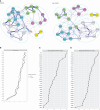Relationships between psychopathological symptoms, pandemic-related stress, perceived social support, and COVID-19 infection history: a network analysis in Chinese college students
- PMID: 38370557
- PMCID: PMC10873916
- DOI: 10.3389/fpsyt.2024.1340101
Relationships between psychopathological symptoms, pandemic-related stress, perceived social support, and COVID-19 infection history: a network analysis in Chinese college students
Abstract
Introduction: Previous coronavirus, 2019 (COVID-19) research has applied network analysis to examine relationships between psychopathological symptoms but rarely extended to potential risk and protective factors or the influence of COVID-19 infection history. This study examined complex inter-relationships between psychopathological symptoms, COVID-19-related stressors, perceived social support, and COVID-19 infection history among Chinese university/college students during the peak of fifth pandemic wave using a network analysis approach.
Methods: A Least Absolute Shrinkage and Selection Operator-regularized partial correlation network using Gaussian graphical model was constructed in 1,395 Chinese university/college students in Hong Kong who completed a survey between 15 March and 3 April, 2022. Depressive, anxiety, and acute/traumatic stress symptoms were measured by Patient Health Questionnaire-9, Generalized Anxiety Disorder-7, and Impact of Event Scale-6, respectively. COVID-19-related stressors and perceived social support were measured. Network differences by COVID-19 infection history (COVID-network vs. no_COVID-network) and network communities were examined.
Results: Our results showed that the most influential nodes were depressed mood, uncontrollable worries, and uncontrollable thoughts about COVID-19. The main bridging symptoms were concentration problems and psychomotor problems. The COVID-network, comprising participants with a history of COVID-19 infection only, was significantly stronger than the no_COVID-network. Perceived social support and stress from conflicts with family/friends formed a unique community with negative cognition and suicidal idea in the COVID-network only.
Conclusion: Our findings indicate that specific interventions targeting interpersonal conflicts and concentration problems as well as facilitating stress buffering effects of social support may represent effective strategies to reduce psychological distress in university/college students during COVID-19 and should be considered for future pandemic preparedness.
Keywords: COVID-19; anxiety; depression; network analysis; social support.
Copyright © 2024 Lee, Chan, Wong, Wong, Lei, So, Fung, Chu, Chung, Cheng, Lo, Chan and Chang.
Conflict of interest statement
The authors declare that the research was conducted in the absence of any commercial or financial relationships that could be construed as a potential conflict of interest.
Figures


Similar articles
-
The correlation between lifestyle health behaviors, coping style, and mental health during the COVID-19 pandemic among college students: Two rounds of a web-based study.Front Public Health. 2023 Jan 12;10:1031560. doi: 10.3389/fpubh.2022.1031560. eCollection 2022. Front Public Health. 2023. PMID: 36711327 Free PMC article.
-
Network analysis on psychopathological symptoms, psychological measures, quality of life and COVID-19 related factors in Chinese psychiatric patients in Hong Kong.BMC Psychiatry. 2024 Apr 12;24(1):271. doi: 10.1186/s12888-024-05690-7. BMC Psychiatry. 2024. PMID: 38609962 Free PMC article.
-
Psychological distress and associated factors of the primary caregivers of offspring with eating disorder during the coronavirus disease 2019 pandemic.J Eat Disord. 2021 Apr 29;9(1):58. doi: 10.1186/s40337-021-00405-9. J Eat Disord. 2021. PMID: 33926562 Free PMC article.
-
The impact of the COVID-19 Pandemic on the Greek population: Suicidal ideation during the first and second lockdown.Psychiatriki. 2021 Dec 20;32(4):267-270. doi: 10.22365/jpsych.2021.041. Epub 2021 Nov 26. Psychiatriki. 2021. PMID: 34860683 English, Greek, Modern.
-
Centrality depression-anxiety symptoms linked to suicidal ideation among depressed college students--A network approach.Psych J. 2023 Oct;12(5):735-745. doi: 10.1002/pchj.668. Epub 2023 Jul 11. Psych J. 2023. PMID: 37433668
Cited by
-
Exploring the association between consultation themes and suicidal ideation: a gender-stratified analysis of Hangzhou Mental Health Hotline (2014-2023).BMC Psychiatry. 2024 Oct 3;24(1):650. doi: 10.1186/s12888-024-06128-w. BMC Psychiatry. 2024. PMID: 39363302 Free PMC article.
-
Does childhood maltreatment influence Chinese preschool education college students' depression and anxiety? Evidence from a latent class analysis.Front Psychol. 2024 Mar 28;15:1341344. doi: 10.3389/fpsyg.2024.1341344. eCollection 2024. Front Psychol. 2024. PMID: 38605832 Free PMC article.
-
Complex associations between anxiety, depression, and resilience in a college student sample: a network analysis.Front Psychiatry. 2025 May 14;16:1502252. doi: 10.3389/fpsyt.2025.1502252. eCollection 2025. Front Psychiatry. 2025. PMID: 40438336 Free PMC article.
References
LinkOut - more resources
Full Text Sources
Miscellaneous

